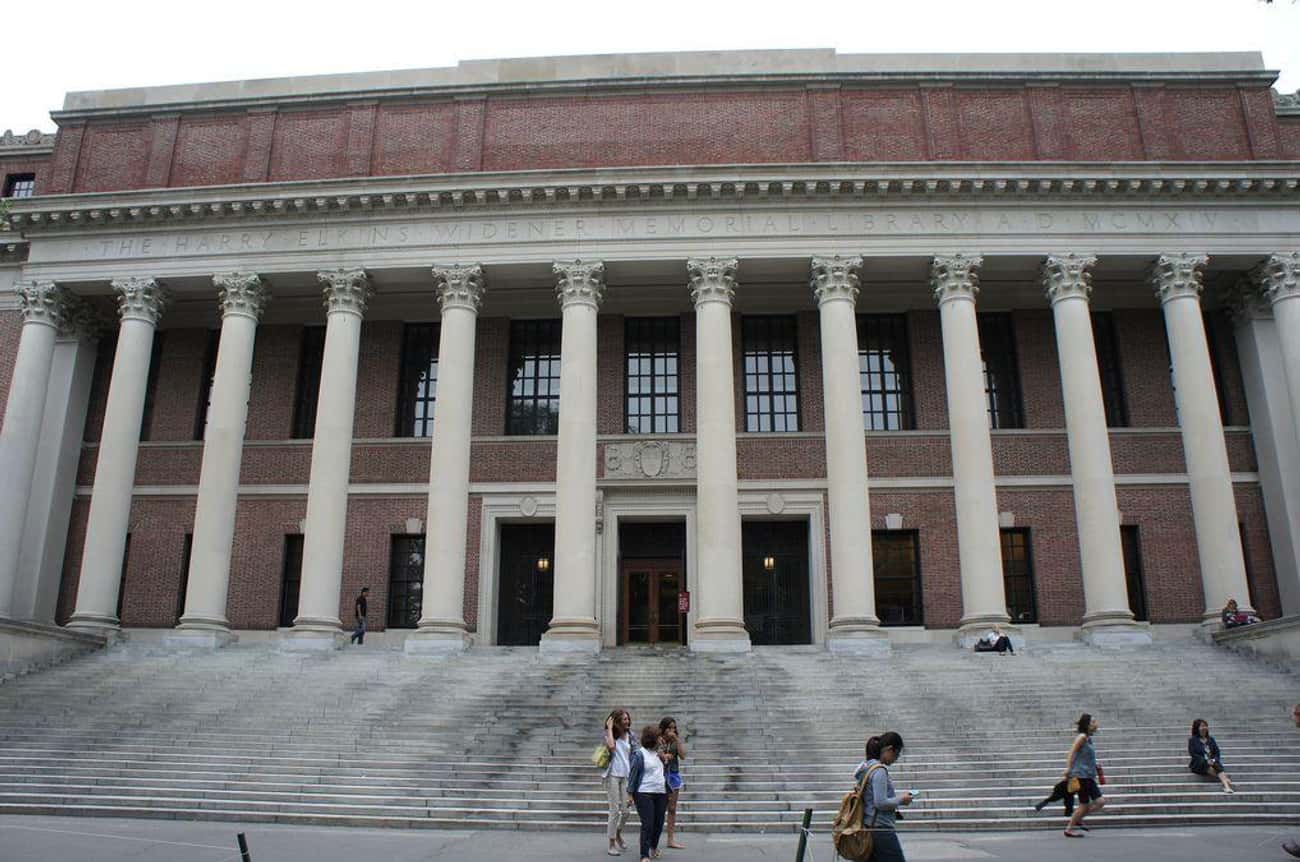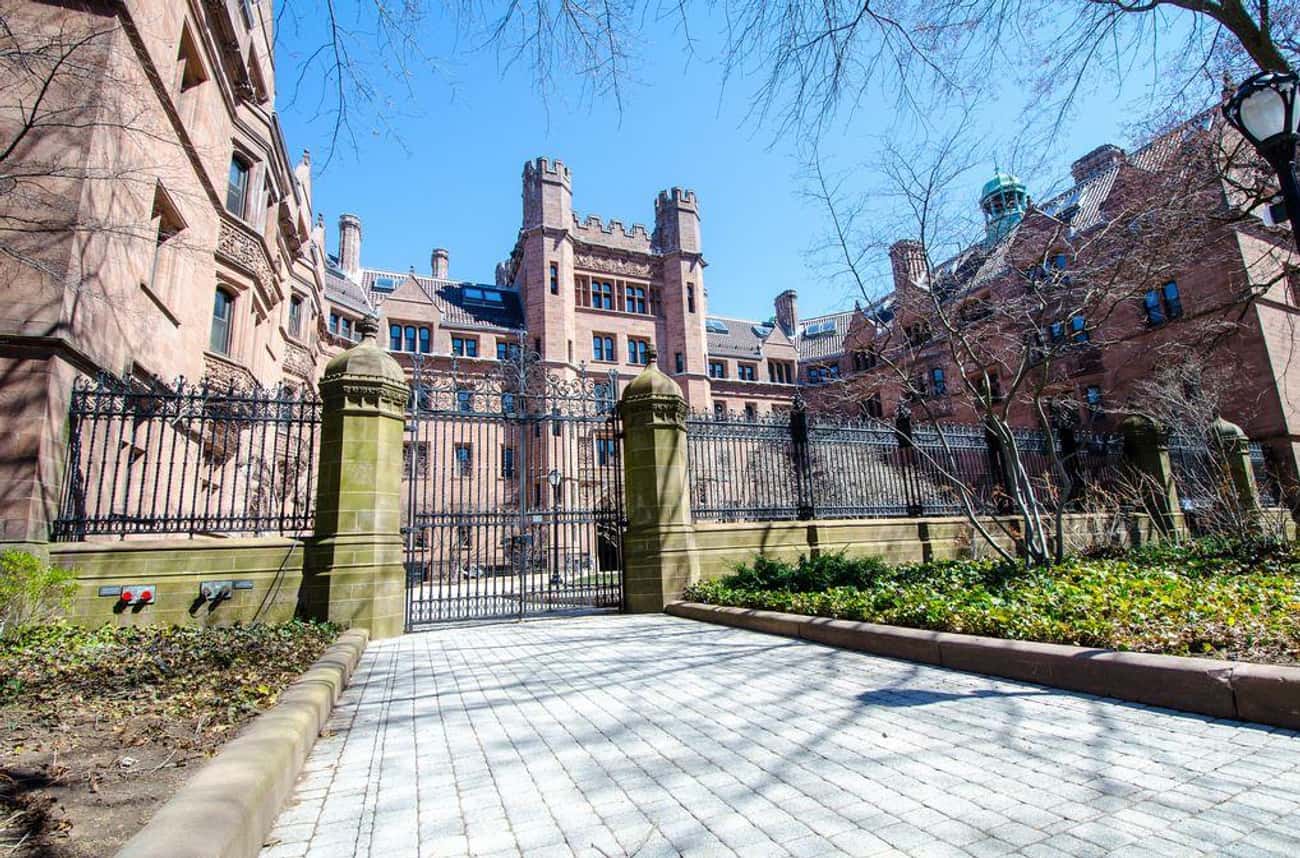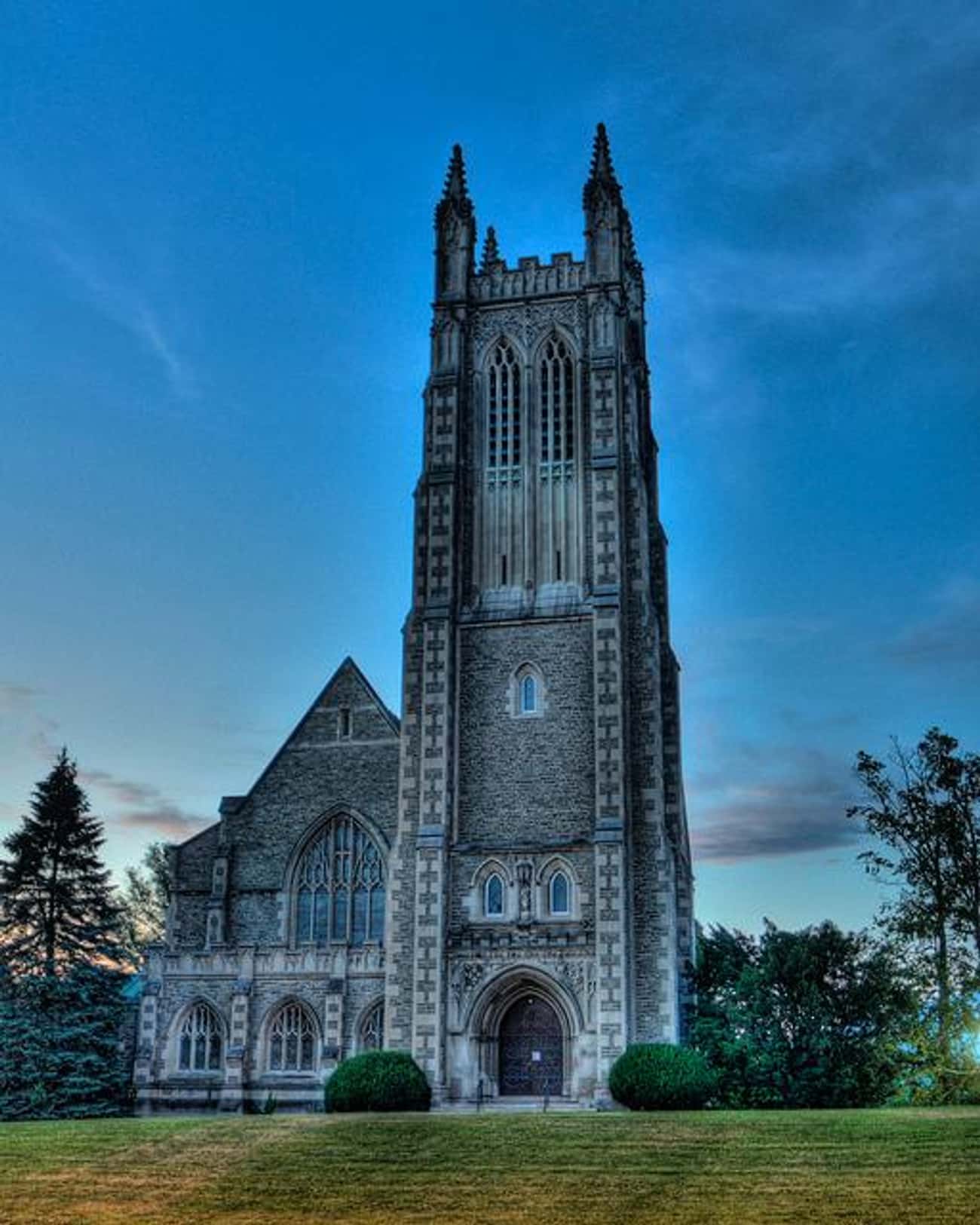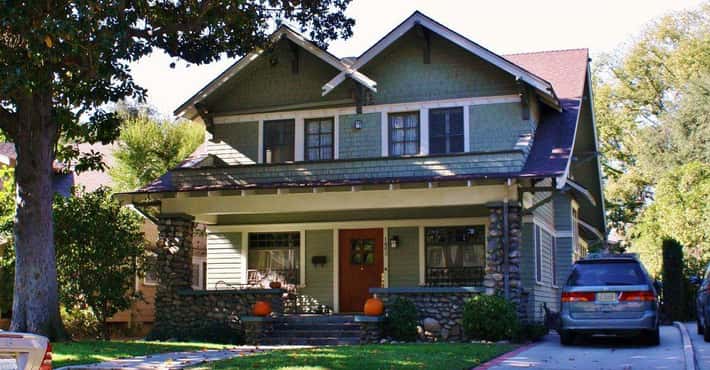Oldest Universities In The US
- Photo: dog97209 / flickr / CC-BY-NC-ND 2.0Harvard University is a private Ivy League research university in Cambridge, Massachusetts, established in 1636. Its history, influence and wealth have made it one of the most prestigious universities in the world. Established originally by the Massachusetts legislature and soon thereafter named for John Harvard, Harvard is the United States' oldest institution of higher learning, and the Harvard Corporation is its first chartered corporation. Although never formally affiliated with any denomination, the early College primarily trained Congregationalist and Unitarian clergy. Its curriculum and student body were gradually secularized during the 18th century, and by the 19th century Harvard had emerged as the central cultural establishment among Boston elites. Following the American Civil War, President Charles W. Eliot's long tenure transformed the college and affiliated professional schools into a modern research university; Harvard was a founding member of the Association of American Universities in 1900. James Bryant Conant led the university through the Great Depression and World War II and began to reform the curriculum and liberalize admissions after the war.More Harvard University
- Dig Deeper...Famous Harvard Lampoon Members
- And Deeper...50+ Celebrities Who Went to Harvard
- #7 of 13 onFacts That Made Us Raise An Eyebrow Or Two When We Found Out They Were True
- Photo: Internet Archive Book Images / flickr / No known copyright restrictionsThe College of William & Mary in Virginia is a public research university located in Williamsburg, Virginia, United States. Privately founded in 1693 by letters patent issued by King William III and Queen Mary II, it is the second-oldest institution of higher education in the United States after Harvard University and the oldest in the American South. William & Mary is considered one of the original "Public Ivies," a term coined by Richard Moll in 1985 for publicly funded universities providing a quality of education claimed to be comparable to that available in the Ivy League. William & Mary educated U.S. Presidents Thomas Jefferson, James Monroe, and John Tyler as well as other key figures important to the development of the nation, including U.S. Supreme Court Chief Justice John Marshall, Speaker of the House Henry Clay, and 16 signers of the Declaration of Independence. W&M founded the Phi Beta Kappa academic honor society in 1776 and was the first school of higher education in the United States to install an honor code of conduct for students. The establishment of graduate programs in law and medicine in 1779 makes it one of the first universities in the United States.
- Yale University is a private Ivy League research university in New Haven, Connecticut. Founded in 1701 as the "Collegiate School" by a group of Congregationalist ministers and chartered by the Colony of Connecticut, the university is the third-oldest institution of higher education in the United States. In 1718, the school was renamed "Yale College" in recognition of a gift from Elihu Yale, a governor of the British East India Company. Established to train Connecticut ministers in theology and sacred languages, by 1777 the school's curriculum began to incorporate humanities and sciences. During the 19th century Yale gradually incorporated graduate and professional instruction, awarding the first Ph.D. in the United States in 1861 and organizing as a university in 1887. Yale is organized into twelve constituent schools: the original undergraduate college, the Graduate School of Arts & Sciences, and ten professional schools. While the university is governed by the Yale Corporation, each school's faculty oversees its curriculum and degree programs.
- Photo: Rob Pettengill / flickr / CC-BY-NC-ND 2.0The University of Pennsylvania is a private, Ivy League, research university located in Philadelphia. Incorporated as The Trustees of the University of Pennsylvania, Penn is one of 14 founding members of the Association of American Universities and one of the nine original Colonial Colleges. Penn has claims to being the oldest university in the United States of America. Benjamin Franklin, Penn's founder, advocated an educational program that focused as much on practical education for commerce and public service as on the classics and theology. The university coat of arms features a dolphin on the red chief, adopted directly from the Franklin family's own coat of arms. Penn was one of the first academic institutions to follow a multidisciplinary model pioneered by several European universities, concentrating multiple "faculties" into one institution. It was also home to many other educational innovations. The first school of medicine in North America, the first collegiate business school and the first "student union" building and organization, were all born at Penn.
- Photo: davedgd / FlickrPrinceton University is a private Ivy League research university in Princeton, New Jersey. Founded in 1746 in Elizabeth as the College of New Jersey, Princeton was the fourth chartered institution of higher education in the American colonies and thus one of the nine Colonial Colleges established before the American Revolution. The institution moved to Newark in 1747, then to the current site nine years later, where it was renamed Princeton University in 1896. Princeton provides undergraduate and graduate instruction in the humanities, social sciences, natural sciences, and engineering. It offers professional degrees through the Woodrow Wilson School of Public and International Affairs, the School of Engineering and Applied Science, the School of Architecture and the Bendheim Center for Finance. The University has ties with the Institute for Advanced Study, Princeton Theological Seminary, and the Westminster Choir College of Rider University. By endowment per student, Princeton is the wealthiest school in the United States. The University has graduated many notable alumni.More Princeton University
- Dig Deeper...Famous Princeton Eating Club Members List
- #5 of 93 onThe Top Dream Colleges
- #3 of 8 onAll Ivy League Colleges Ranked
- Washington and Lee University is a private liberal arts university in Lexington, Virginia, United States. Washington and Lee's 325 acre campus sits at the heart of Lexington and abuts the Virginia Military Institute in the Shenandoah Valley region of Virginia between the Blue Ridge Mountains and the Allegheny Mountains. The rural campus is approximately 50 miles from Roanoke, Virginia, 140 miles from Richmond, Virginia, and 180 miles from Washington, D.C. Washington and Lee was founded in 1749 as a small classical school by Scots-Irish Presbyterian pioneers, though the University has never claimed any sectarian affiliation. In 1796, George Washington endowed the struggling academy with a gift of stock. In gratitude, the school was renamed for the first United States President. In 1865, General Robert E. Lee served as president of the college until his death in 1870, prompting the college to be renamed as Washington and Lee University. Washington and Lee is the ninth oldest institution of higher learning in the United States and the second oldest in Virginia.
- Columbia University in the City of New York, or simply Columbia University, is an American private Ivy League research university located in Morningside Heights, in Upper Manhattan, New York City. It is the oldest institution of higher learning in the State of New York, the fifth oldest in the United States, and one of the country's nine Colonial Colleges founded before the American Revolution. The university was founded in 1754 as King's College by royal charter of George II of Great Britain. After the American Revolutionary War, King's College briefly became a state entity, and was renamed Columbia College in 1784. The University now operates under a 1787 charter that places the institution under a private board of trustees, and in 1896 it was further renamed Columbia University. That same year, the university's campus was moved from Madison Avenue to its current location in Morningside Heights, where it occupies more than six city blocks, or 32 acres. Today the university operates Columbia Global Centers overseas in Amman, Beijing, Istanbul, Paris, Mumbai, Rio de Janeiro, Santiago and Nairobi.More Columbia University
- Dig Deeper...Drama & Theater Schools in the US
- #8 of 79 onThe Best Medical Schools in the US
- #6 of 93 onThe Top Dream Colleges
- Brown University is a private Ivy League research university in Providence, Rhode Island. Founded in 1764 as "The College in the English Colony of Rhode Island and Providence Plantations," Brown is the seventh-oldest institution of higher education in the United States and one of the nine Colonial Colleges established before the American Revolution. At its foundation, Brown was the first college in the United States to accept students regardless of their religious affiliation. Its engineering program, established in 1847, was the first in what is now known as the Ivy League. Brown's New Curriculum—sometimes referred to in education theory as the Brown Curriculum—was adopted by faculty vote in 1969 after a period of student lobbying; the New Curriculum eliminated mandatory "general education" distribution requirements, made students "the architects of their own syllabus," and allowed them to take any course for a grade of satisfactory or unrecorded no-credit. In 1971, Brown's coordinate women's institution, Pembroke College, was fully merged into the university.More Brown University
- Dig Deeper...Drama & Theater Schools in the US
- #30 of 79 onThe Best Medical Schools in the US
- #13 of 93 onThe Top Dream Colleges
- Photo: llee_wu / FlickrRutgers, The State University of New Jersey, commonly referred to as Rutgers University, Rutgers, or RU, is an American public research university and the largest institution for higher education in New Jersey. Originally chartered as Queen's College on November 10, 1766, Rutgers is the eighth-oldest college in the United States and one of the nine "Colonial Colleges" founded before the American Revolution. The college was renamed Rutgers College in 1825 in honor of Colonel Henry Rutgers, a New York City landowner, philanthropist and former military officer, whose generous donation to the school allowed it to reopen after years of financial difficulty. For most of its existence, Rutgers was a private liberal arts college affiliated with the Dutch Reformed Church and admitted only male students. The college expanded its role in research and instruction in agriculture, engineering, and science when it was named as the state's sole land-grant college in 1864 under the Morrill Act of 1862. It gained university status in 1924 with the introduction of graduate education and further expansion.
- Photo: BFS Man / flickr / CC-BY-NC 2.0Dartmouth College, commonly referred to as Dartmouth, is a private Ivy League research university located in Hanover, New Hampshire, United States. It consists of a liberal arts college, the Geisel School of Medicine, the Thayer School of Engineering, and the Tuck School of Business, as well as 19 graduate programs in the arts and sciences. Incorporated as the "Trustees of Dartmouth College," it is one of the nine Colonial Colleges founded before the American Revolution. With an undergraduate enrollment of 4,276 and a total student enrollment of 6,342, Dartmouth is the smallest university in the Ivy League. Dartmouth College was established in 1769 by Eleazar Wheelock, a Congregational minister. After a long period of financial and political struggles, Dartmouth emerged in the early 20th century from relative obscurity. Dartmouth's somewhat-isolated rural 269-acre campus is in the Upper Valley region of New Hampshire. Participation in athletics and the school's Greek system is strong. Dartmouth's 34 varsity sports teams compete in the Ivy League conference of the NCAA Division I. Students are well known for preserving a variety of strong campus traditions.
- Photo: hdes.copeland / flickr / CC-BY-NC 2.0The College of Charleston is a public, sea-grant and space-grant university located in historic downtown Charleston, South Carolina, United States. The college was founded in 1770 and chartered in 1785, making it the oldest college or university in South Carolina, the 15th oldest institution of higher learning in the United States and the oldest municipal college in the country. The founders of the College include three future signers of the Declaration of Independence and three future signers of the United States Constitution. It is said that the college was founded to "encourage and institute youth in the several branches of liberal education." The college is in company with the Colonial Colleges as one of the oldest schools in the United States. It is a member of the Council of Public Liberal Arts Colleges, the American Association of State Colleges and Universities and the Association of Public and Land-grant Universities.
- Salem College is a liberal arts women's college in Winston-Salem, North Carolina, United States founded in 1772. Originally established as a primary school, it later became an academy and finally a college. It is the oldest female educational establishment that is still a women's college and the oldest female institution in the Southern United States. Though Salem is officially classified as a women's college, men 23 years of age and over are admitted into the Continuing Education program and into graduate-degree programs. In 2009, Forbes rated it 67th of America's Best Colleges.
- Photo: House Divided Project / flickr / CC-BY-NC 2.0Dickinson College is a private, residential liberal arts college in Carlisle, Pennsylvania, United States. Founded in 1773 as Carlisle Grammar School, Dickinson was chartered September 9, 1783, six days after the signing of the Treaty of Paris, making it the first college to be founded after the formation of the United States. Dickinson was founded by Benjamin Rush, a signer of the United States Declaration of Independence. It was originally named "John and Mary's College" in honor of John Dickinson, a signer of the Constitution who was later the President of Pennsylvania, and his wife Mary Norris Dickinson. They donated much of their extensive personal libraries to the new college. Dickinson College is the 16th-oldest college in the United States. With over 240 full-time faculty members and an enrollment of nearly 2,400 students, Dickinson has been recognized for its innovative curriculum and international education programs. For example, Dickinson sponsors 12 study centers in other countries. Its approach to global education has received national recognition from the American Council on Education and NAFSA: Association of International Educators.
- Photo: Metaweb (FB) / Public domainHampden–Sydney College, also known as H-SC, is a liberal arts college for men located in Hampden Sydney, Virginia, United States. Founded in 1775, Hampden–Sydney is the oldest private charter college in the Southern U.S., the last college founded before the American Revolution, and one of only three four-year, all-men's liberal arts colleges in the United States.
- Photo: Metaweb (FB) / CC-BYTransylvania University is a private university in Lexington, Kentucky, United States. It was founded in 1780, making it the first university in Kentucky and among the oldest in the United States. It offers 36 major programs, as well as dual-degree engineering programs, and is accredited by the Southern Association of Colleges and Schools. Transylvania's name, meaning "across the woods" in Latin, stems from the university's founding in the heavily forested region of western Virginia known as the Transylvania colony, which became most of Kentucky in 1792. Transylvania is an aspiring research institution. It has been cited for outstanding value and academic quality by such publications as U.S. News & World Report and Forbes. Among its impacts, Transylvania is the alma mater of two U.S. vice presidents, two U.S. Supreme Court justices, fifty U.S. senators, 101 U.S. representatives, 36 U.S. governors, and 34 U.S. ambassadors, making it a large producer of U.S. statesmen. It also educated Confederate President Jefferson Davis, prior to his transfer to the United States Military Academy at West Point. Its medical program graduated 8000 physicians by 1859.
- Photo: Internet Archive Book Images / flickr / No known copyright restrictionsWashington & Jefferson College, also known as W & J College or W&J, is a private liberal arts college in Washington, Pennsylvania, in the United States, which is 30 miles south of Pittsburgh. The college traces its origin to three log cabin colleges in Washington County established by three Presbyterian missionaries to the American frontier in the 1780s: John McMillan, Thaddeus Dod, and Joseph Smith. These early schools eventually grew into two competing academies and colleges, with Canonsburg Academy, later Jefferson College, located in Canonsburg and Washington Academy, later Washington College, in Washington. These two colleges merged in 1865 to form Washington & Jefferson College. The 60-acre campus, located in Washington, Pennsylvania, has more than 40 buildings, with the oldest dating to 1793. While the college has historically had a difficult relationship with the city of Washington, including clashes over college expansion and finances, recent efforts have been made to improve those relations. The college's academic emphasis is on the liberal arts and the sciences, with a focus on preparing students for graduate and professional schools.
- Washington College is a private, independent liberal arts college located on a 112-acre campus in Chestertown, Maryland, on the Eastern Shore. Maryland granted Washington College its charter in 1782. George Washington supported the founding of the college by consenting to have the "College at Chester" named in his honor, through generous financial support, and through service on the college's Board of Visitors and Governors. Washington College is the 10th-oldest college in the United States and was the first college chartered after American independence. The school became coeducational in 1891.
- Photo: Metaweb (FB) / Fair useThe University of Georgia, founded in 1785, and commonly referred to as UGA or simply Georgia, is an American land-grant university and sea grant research university. Its primary campus is located on a 759-acre campus in Athens, Georgia, USA. It is considered Georgia's flagship university. The university is ranked 20th overall among all public national universities in the current 2014 U.S. News & World Report rankings consistently ranks within the top 500 international universities worldwide across numerous publications. While having high marks, including top 10 evaluations in particular fields of various studies. The University of Georgia is a part of the University System of Georgia and is accredited by the Southern Association of Colleges and Schools. Founded in 1785 as the United States' first state-chartered university, it is the oldest and largest of Georgia's institutions of higher learning and along with the College of William and Mary and the University of North Carolina at Chapel Hill claims the title of the oldest public university in the United States. The university's historic North Campus is on the U.S.
- Dig Deeper...The Cheapest Colleges in America
- And Deeper...Spike The Bulldog Mascot School List
- #21 of 66 onUniversities With the Best College Sports Programs
- Franklin & Marshall College is a four-year private co-educational residential national liberal arts college in the Northwest Corridor neighborhood of Lancaster, Pennsylvania, United States. It employs 175 full-time faculty members and has a student body of approximately 2,324 full-time students. F&M was ranked 37 on U.S. News & World Report's 2014 list of liberal arts colleges. The New York Times ranked F&M 26th in a ranking of "The Most Economically Diverse Top Colleges" in 2014. In 2011 F&M was ranked as the 4th Most Rigorous College/University on Newsweek's "The Daily Beast". Forbes' 2009 list of "America's Best Colleges" ranked the school 36th overall, and 33rd among private colleges. It was also ranked #1 in the nation for "Faculty accessibility" by The Princeton Review in 2003. The college is a member of the Centennial Conference. For the Class of 2012 Admissions Cycle, the acceptance rate dropped to 35.9%, making it F&M's most selective class yet while increasing the admissions profile. The average SAT score is 1311, which combines the Critical Reading and Math portions. The average class size is 19 students, and the student-faculty ratio is 9:1.
- The University of Pittsburgh is a state-related research university located in Pittsburgh, Pennsylvania. It was founded on the edge of the American frontier as the Pittsburgh Academy in 1787, and evolved into the Western University of Pennsylvania by alteration of its charter in 1819. After surviving two devastating fires and various relocations within the area, the school moved to its current location in the Oakland neighborhood of the city and was renamed to the University of Pittsburgh in 1908. For most of its history Pitt was a private institution, until it became part of the Commonwealth System of Higher Education in 1966. The university is composed of 17 undergraduate and graduate schools and colleges located at its urban Pittsburgh campus, home to the university's central administration and 28,766 undergraduate, graduate, and professional students. The university also includes four additional undergraduate schools located at campuses within Western Pennsylvania: Bradford, Greensburg, Johnstown, and Titusville.
- Photo: Metaweb (FB) / CC-BY-SA-2.0Castleton University, formerly known as Castleton State College, is a public liberal arts college, located in Castleton in the U.S. state of Vermont. Castleton has an enrollment of 2000 students and offers more than 30 undergraduate programs, as well as master's degrees in education and accounting. The college is accredited by the New England Association of Schools and Colleges.
- Photo: ehpien / flickr / CC-BY-NC-ND 2.0Georgetown University is a private research university in Washington, D.C. Founded in 1789, it is the oldest Catholic and Jesuit institution of higher education in the United States. Georgetown's main campus, located in Washington's Georgetown neighborhood, is noted for Healy Hall, a National Historic Landmark in the Romanesque revival style. Georgetown's law school is located on Capitol Hill and Georgetown has auxiliary campuses in Italy, Turkey, and Qatar. Georgetown's founding by John Carroll, America's first Catholic bishop, realized earlier efforts to establish a Roman Catholic college in the province of Maryland that had been thwarted by religious persecution. The university expanded after the American Civil War under the leadership of Patrick Francis Healy, who came to be known as Georgetown's "second founder" despite having been born a slave by law. Jesuits have participated in the university's administration since 1805, a heritage Georgetown celebrates, but the university has always been governed independently of the Society of Jesus and of church authorities.
- Dig Deeper...The Greatest Georgetown Basketball Players of All Time
- #63 of 66 onUniversities With the Best College Sports Programs
- #16 of 93 onThe Top Dream Colleges
- Photo: *Ken Lane* / flickr / CC-BY-NC-ND 2.0The University of North Carolina at Chapel Hill, also known as UNC, UNC-Chapel Hill, Chapel Hill, North Carolina, or simply Carolina, is a coeducational public research university located in Chapel Hill, North Carolina, United States. North Carolina has been consistently listed among the highest and best ranked universities in the United States and is one of the original eight Public Ivy schools that are claimed to provide an Ivy League experience for a public schooling price. After being chartered in 1789, the university first began enrolling students in 1795, which allows it to be one of three schools to claim the title of the oldest public university in the United States. The first public institution of higher education in North Carolina, the school opened its doors to students on February 12, 1795. The university offers degrees in over 70 courses of study through fourteen colleges and the College of Arts and Sciences. All undergraduates receive a liberal arts education and have the option to pursue a major within the professional schools of the university or within the College of Arts and Sciences from the time they obtain junior status.
- Photo: aidaneus / flickr / CC-BY-NC-ND 2.0The University of Vermont and State Agricultural College, more commonly known as the University of Vermont or UVM, is a public research university and, after 1862, the U.S. state of Vermont's land-grant university. The University of Vermont is labeled one of the original "Public Ivies," a publicly funded university considered as providing a quality of education comparable to those of the Ivy League. Founded in 1791, UVM is among the oldest universities in the United States and the fifth college established in New England after Harvard, Yale, Dartmouth and Brown. The university's 451-acre campus is located in Burlington. Features of the UVM campus include the historic University Green, the Dudley H. Davis Center—the first student center in the nation to receive U.S. Green Building Council LEED Gold certification—the Fleming Museum of Art, and the Gutterson/Patrick athletic complex, home to UVM's Division I athletic teams. The largest hospital complex in Vermont, The University of Vermont Medical Center, has its primary facility adjacent to the UVM campus and is affiliated with the UVM College of Medicine.
- Photo: Kim Carpenter / FlickrWilliams College is a private liberal arts college located in Williamstown, Massachusetts, United States. It was established in 1793 with funds from the estate of Ephraim Williams. Originally a men's college, Williams became co-educational in 1970. Fraternities were also phased out during this period, beginning in 1962. Williams has three academic curricular divisions, 24 departments, 36 majors, and two master's degree programs in art history and development economics. There are 334 voting faculty members, with a student-to-faculty ratio of 7:1. As of 2012, the school has an enrollment of 2,052 undergraduate students and 54 graduate students. The academic year follows a 4–1–4 schedule of two four-course semesters plus a one-course "winter study" term in January. A summer research schedule involves about 200 students on campus completing projects with professors. Williams College currently occupies 1st place in U.S. News & World Report 's 2014 ranking of the 266 liberal arts colleges in the United States.
- Photo: Guanatos Gwyn / flickr / CC-BY-NC-ND 2.0Bowdoin College is a private liberal arts college located in the coastal Maine town of Brunswick. Founded in 1794, the college currently enrolls 1,839 students, and has been coeducational since 1971. Bowdoin offers 33 majors and 4 additional minors, and has a student-faculty ratio of 9:1. Famous alumni include Nathaniel Hawthorne, Henry Wadsworth Longfellow, Thomas Brackett Reed, Franklin Pierce, and Joshua Chamberlain. Bowdoin has an acceptance rate of 14.5% and was listed as the fourth-best liberal arts college in the U.S. in the 2014 U.S. News & World Report rankings. Bowdoin is located on the shores of Casco Bay and the Androscoggin River, 12 miles north of Freeport, Maine, and 28 miles north of Portland, Maine. In addition to its Brunswick campus, Bowdoin also owns a 118-acre coastal studies center on Orr's Island and a 200-acre scientific field station on Kent Island in the Bay of Fundy.
- Photo: AL904 / flickr / CC-BY-NC-ND 2.0The University of Tennessee is a public sun-grant and land-grant university headquartered in Knoxville, Tennessee, United States. Founded in 1794, two years before Tennessee entered the Union as the 16th state, it is the flagship institution of the statewide University of Tennessee system with nine undergraduate colleges and eleven graduate colleges and hosts almost 28,000 students from all 50 states and more than 100 foreign countries. In its 2014 ranking of universities, U.S. News & World Report ranked UT 106th among all national universities and 46th among public institutions of higher learning. Seven alumni have been selected as Rhodes Scholars; James M. Buchanan, M.S. '41, received the 1986 Nobel Prize in Economics. UT's ties to nearby Oak Ridge National Laboratory, established under UT President Andrew Holt and continued under the UT-Battelle partnership, allow for considerable research opportunities for faculty and students. Also affiliated with the university are the Howard H. Baker, Jr.
- Dig Deeper...The Greatest Tennessee Basketball Players of All Time
- #26 of 66 onUniversities With the Best College Sports Programs
- #3 of 25 onThe Best College Dance Teams
- Union College is a private, non-denominational liberal arts college located in Schenectady, New York, United States. Founded in 1795, it was the first institution of higher learning chartered by the New York State Board of Regents. In the 19th century, it became the "Mother of Fraternities", as three of the earliest such organizations were established there. After 175 years as a traditional all-male institution, Union College began enrolling women in 1970. The college offers a liberal arts curriculum across some 21 academic departments, as well as opportunities for interdepartmental majors and self-designed organizing theme majors. In common with most liberal arts colleges, Union offers a wide array of courses in arts, sciences, literature, and foreign languages, but, in common with only a few other liberal arts colleges, Union also offers ABET-accredited undergraduate degrees in computer engineering, electrical engineering, and mechanical engineering. Approximately 25% of students major in the social sciences; 9% in history; 10% in psychology; 11% in engineering; 10% in biology; 10% in the liberal arts; while some 5% design their own majors.
- The University of Louisville is a public university in Louisville, Kentucky, a member of the Kentucky state university system. When founded in 1798, it was the first city-owned public university in the United States and one of the first universities chartered west of the Allegheny Mountains. The university is mandated by the Kentucky General Assembly to be a "Preeminent Metropolitan Research University". U of L enrolls students from 118 of 120 Kentucky counties, all 50 U.S. states, and 116 countries around the world. Researchers from the University of Louisville Health Sciences Center participated in the development of a highly effective vaccine against cervical cancer in 2006, the first fully self-contained artificial heart transplant surgery, the first successful hand transplantation, and the development of the Pap test. The University Hospital is also credited with the first civilian ambulance, the nation's first accident services, now known as an emergency room, and one of the first blood banks in the US. Between 1999 and 2006 U of L was one of the fastest growing medical research institutions according to National Institutes of Health rankings.
- Photo: Dfscgt21 / Wikimedia Commons / CC BY-SA 3.0The University of South Carolina is a public, co-educational research university located in Columbia, South Carolina, United States, with seven satellite campuses. Its campus covers over 359 acres in downtown Columbia not far from the South Carolina State House. The University is categorized by the Carnegie Foundation for the Advancement of Teaching as having "very high research activity" and curricular community engagement. It has been ranked as an "up-and-coming" university by U.S. News & World Report, and its undergraduate and graduate International Business programs have ranked among the top three programs in the nation for over a decade. It also houses the largest collection of Robert Burns and Scottish literature materials outside of Scotland, and the largest Ernest Hemingway collection in the world. Founded in 1801 as South Carolina College, South Carolina is the flagship institution of the University of South Carolina System and offers more than 350 programs of study leading to bachelor's, master's, and doctoral degrees from fourteen degree-granting colleges and schools.
- Dig Deeper...The Greatest South Carolina Basketball Players of All Time
- And Deeper...Gamecock Mascot School List
- #53 of 66 onUniversities With the Best College Sports Programs




































































